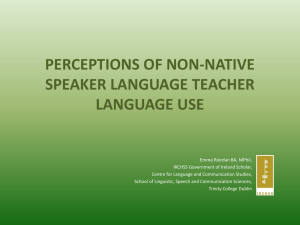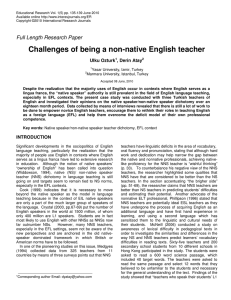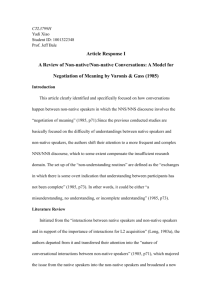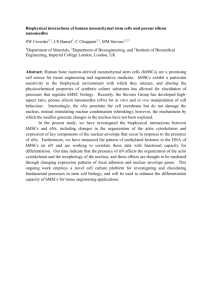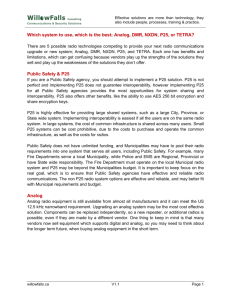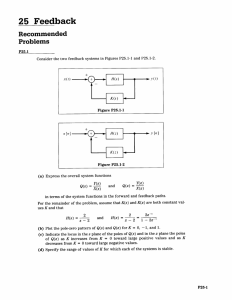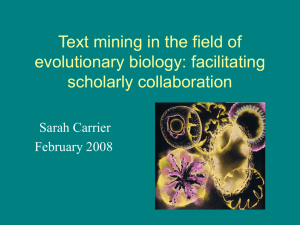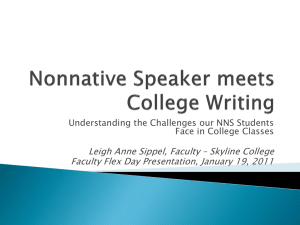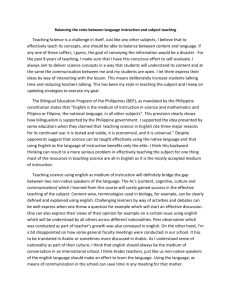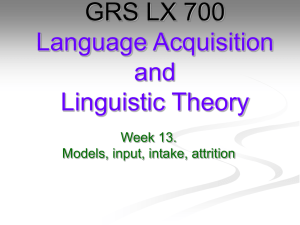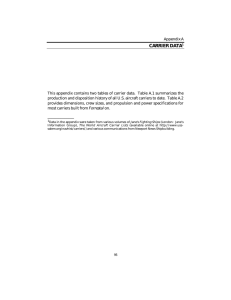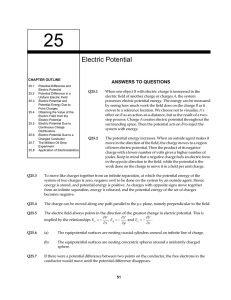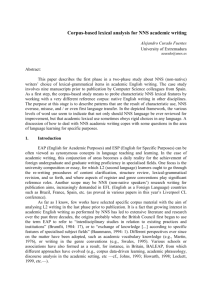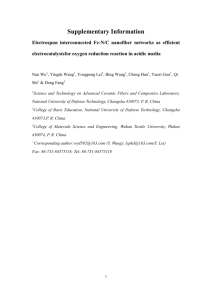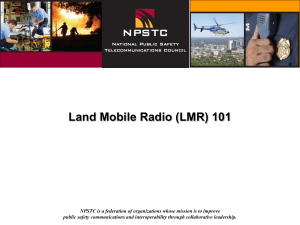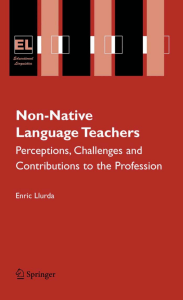How can we motivate students through our non
advertisement
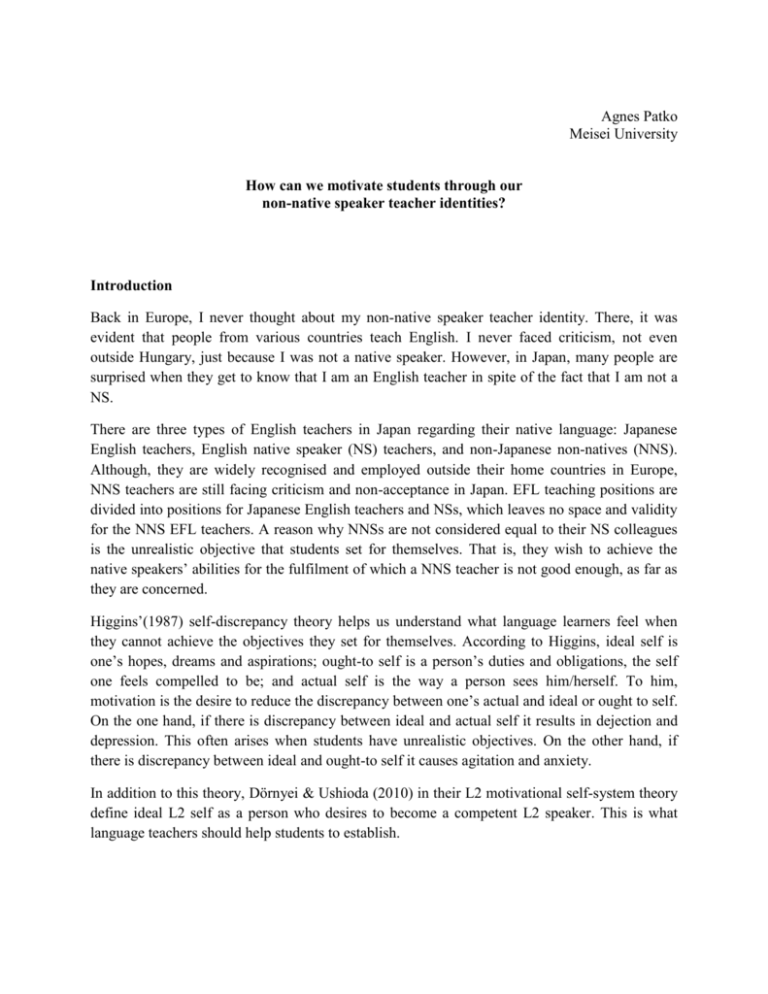
Agnes Patko Meisei University How can we motivate students through our non-native speaker teacher identities? Introduction Back in Europe, I never thought about my non-native speaker teacher identity. There, it was evident that people from various countries teach English. I never faced criticism, not even outside Hungary, just because I was not a native speaker. However, in Japan, many people are surprised when they get to know that I am an English teacher in spite of the fact that I am not a NS. There are three types of English teachers in Japan regarding their native language: Japanese English teachers, English native speaker (NS) teachers, and non-Japanese non-natives (NNS). Although, they are widely recognised and employed outside their home countries in Europe, NNS teachers are still facing criticism and non-acceptance in Japan. EFL teaching positions are divided into positions for Japanese English teachers and NSs, which leaves no space and validity for the NNS EFL teachers. A reason why NNSs are not considered equal to their NS colleagues is the unrealistic objective that students set for themselves. That is, they wish to achieve the native speakers’ abilities for the fulfilment of which a NNS teacher is not good enough, as far as they are concerned. Higgins’(1987) self-discrepancy theory helps us understand what language learners feel when they cannot achieve the objectives they set for themselves. According to Higgins, ideal self is one’s hopes, dreams and aspirations; ought-to self is a person’s duties and obligations, the self one feels compelled to be; and actual self is the way a person sees him/herself. To him, motivation is the desire to reduce the discrepancy between one’s actual and ideal or ought to self. On the one hand, if there is discrepancy between ideal and actual self it results in dejection and depression. This often arises when students have unrealistic objectives. On the other hand, if there is discrepancy between ideal and ought-to self it causes agitation and anxiety. In addition to this theory, Dörnyei & Ushioda (2010) in their L2 motivational self-system theory define ideal L2 self as a person who desires to become a competent L2 speaker. This is what language teachers should help students to establish. Motivation in the language classroom According to Dörnyei and Ushioda’s defenition, motivation is ‘what moves a person to make certain choices, to engage in action, to expend effort and persist in action’ (2010, p. 3.). It is a key point in language learning. There is great difference between the improvement of a motivated and an unmotivated learner. Therefore, teachers need to make efforts to create an environment which helps students develop and maintain motivation. Dörnyei’s (2001) motivational teaching practice model has four main pillars: • Creating the basic motivational conditions • Generating initial motivation • Maintaining and protecting motivation • Encouraging a positive retrospective self-evaluation His framework gives a guideline to teachers how to foster students’ motivation. Motivating as a NNS Research has revealed that both NS and NNS teachers have their advantages and disadvantages (e.g. Árva & Medgyes (2000), Madris & Canado (2004), Meadows & Marumatsu (2007), Medgyes (1992), Merino (1997)). It is true that a NNS cannot compete with the native speakers’ range of vocabulary and communicative competence; however, a native speaker will never understand completely what difficulties the learners are facing. It is because, even if they have learnt foreign languages themselves, they cannot fully understand the difficulties connected to English language learning. NNS teachers are able to share experiences of anxiety and ways to overcome it, help with introducing learning strategies that worked for them, and serve as an example of a successful language learner. They can emphasise world Englishes and prove the usefulness of speaking a foreign language. The above characteristics also make NNS capable of helping students define their own realistic and achievable goals. As a NNS, I attempt to raise my students’ awareness of the points above and motivate them to find their own, achievable objectives and approach it step by step as I did. I also introduce my own culture to them and emphasise how English has been a means of self-actualisation to me. I try to motivate them to see the joy and the challenge in learning and speaking English and strive to see them progress and learn to love the language as I did. Meisei University actively promotes world Englishes. On the one hand, besides NS English teachers, International Studies Centre employs NNS EFL teachers from various countries. On the other hand, Meisei Summer School Project (MSSP) provides another great opportunity for students to meet, talk to and work with several nationalities. During the summer school, Meisei students teach English to local children. They have to work in teams and each teaching team is assigned one or two international volunteers. This project also helps them realise that English is not only spoken by NS, in addition, international volunteers serve as role models of successful language learners. In the classroom What happens in the NNS teacher’s classroom is probably not significantly different from that of a NS’s. Activities, games and projects that I introduce briefly in the following part are the ones that I and my students have found motivating and useful. Projects, and presentations enhance cooperation and collaboration. Students need to do some research, create a tangible final product, such as a poster or a story book and give presentations as a group or individually. Drama creation, that is, story telling in groups. It is a good chance to make students use certain vocabulary items. As a follow up activity, students may make story boards or pictures books. I often take to the class or make students create their own flashcards. They can be utilized in several activities, such as memory games, domino, or card games. As many of my students commute from far-away places, they are usually tired or sleepy when they get into the classroom. Activities involving movement are not only enjoyable but also wake them up. Running dictation, running reading comprehension, treasure hunt or gesture games are effective when students are about to fall asleep. Summary Motivation is a key factor in language learning. Although, it depends on various factors, teachers – regardless of being NSs or not - are able to create an environment in the classroom where students can more easily find and maintain motivation and set achievable L2 related objectives. As a NNS I am attempting to make use of my own prior learning experiences and raise my students’ awareness of world Englishes. In my classes many of the activities are not only enjoyable for the students but they also foster collaboration and make students use English for various purposes in a number of situations. References Árva, V., Medgyes, P. (2000) ‘Native and non-native teachers in the language classroom.’ System 28. 355-372 Dörnyei, Z. (2001). Teaching and researching motivation. London: Longman. Dörnyei, Z., & Ushioda, E. (2010). Teaching and researching motivation (2nd ed.). London: Longman. Higgins, E. T. (1987). Self-discrepancy: A theory of relating self and affect. Psychological Review, 94, 319-340. Llurda, E. (Ed.), Non-Native Language Teachers. Perceptions, Challenges and Contributions to the Profession,13-23. Madris, D., Canado, L. (2004) ‘Teacher and student preferences of native and non-native foreign language teachers.’ Porta Linguarum. Meadows, B., Marumatsu, Y. (2007) ‘Native speaker or non-native speaker teacher?; a report of student preferences in four different foreign language classrooms.’ Arizona Working Papers in SLA & Testing, 14, 95- 109 Medgyes, P. (1992) ‘Native or non-native: Who’s worth more?’ ELT Journal, Volume 46/4 October Oxford University Press Merino, I. (1997) Native-English speaking teachers versus non-native English speaking teachers.’ Revista Alicantina de Estudios Ingleses 10, 69-79
